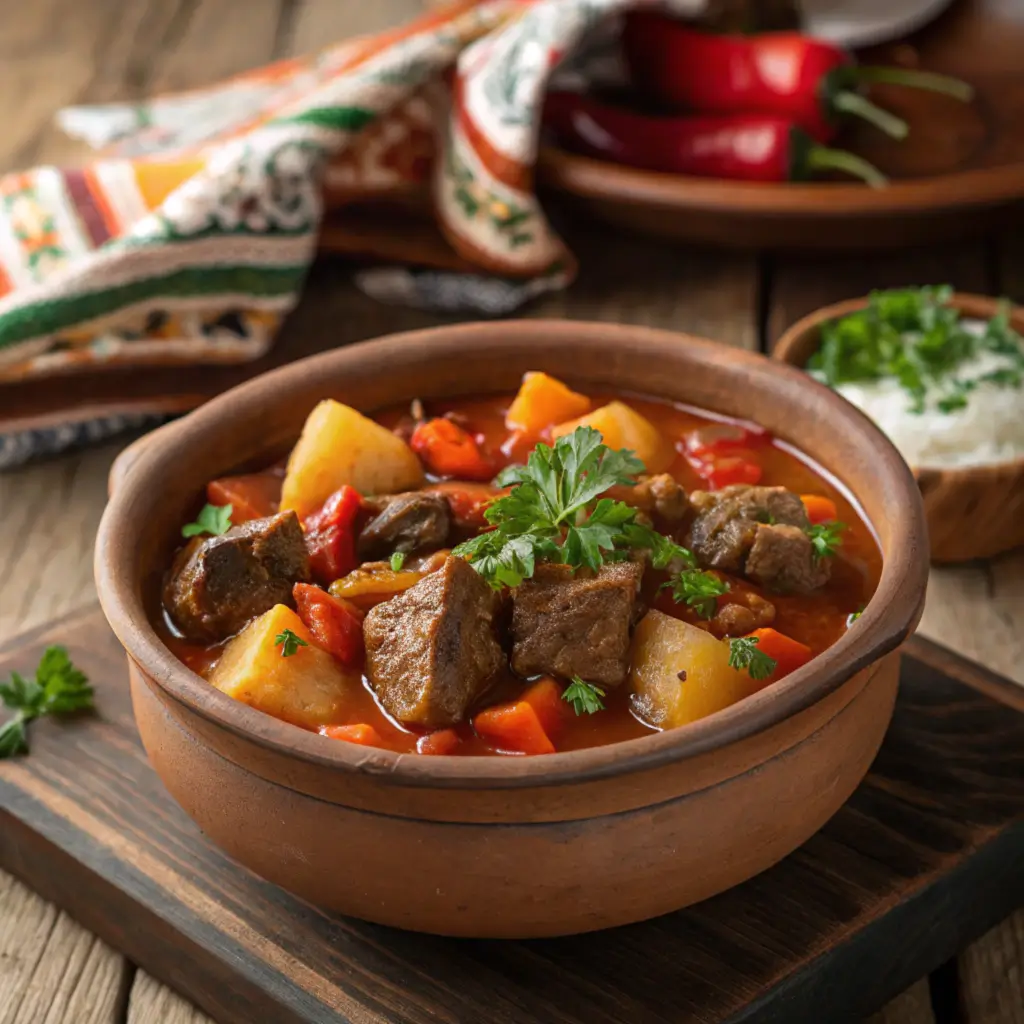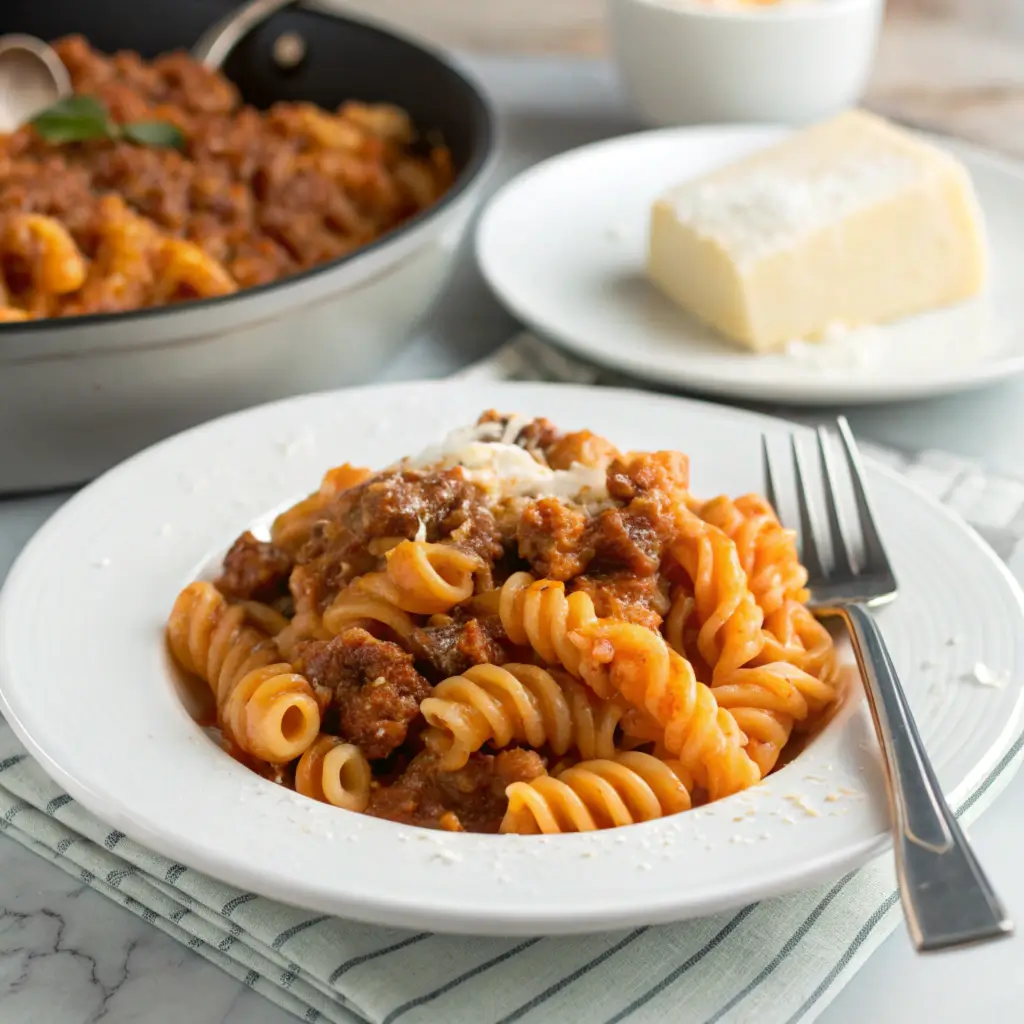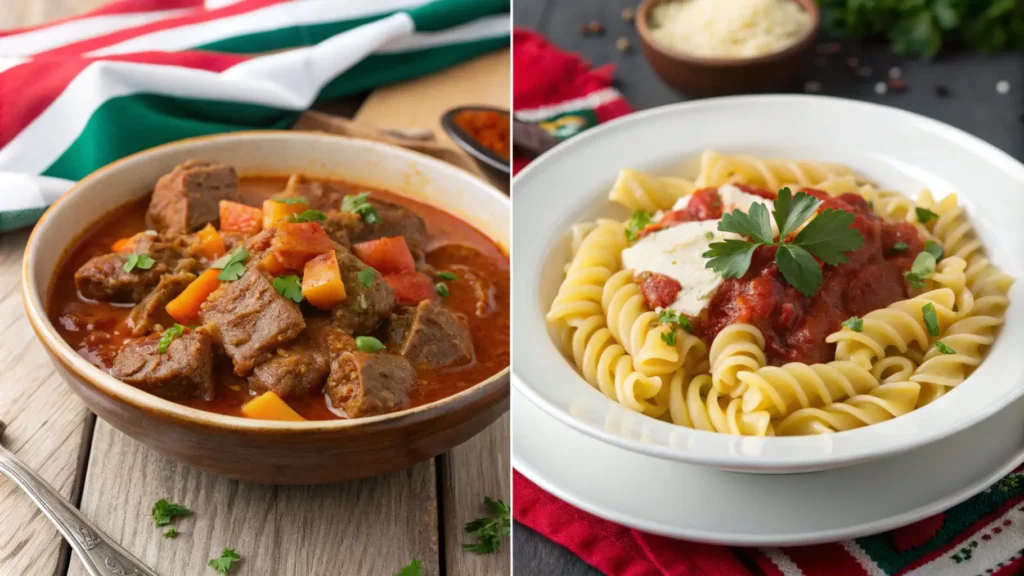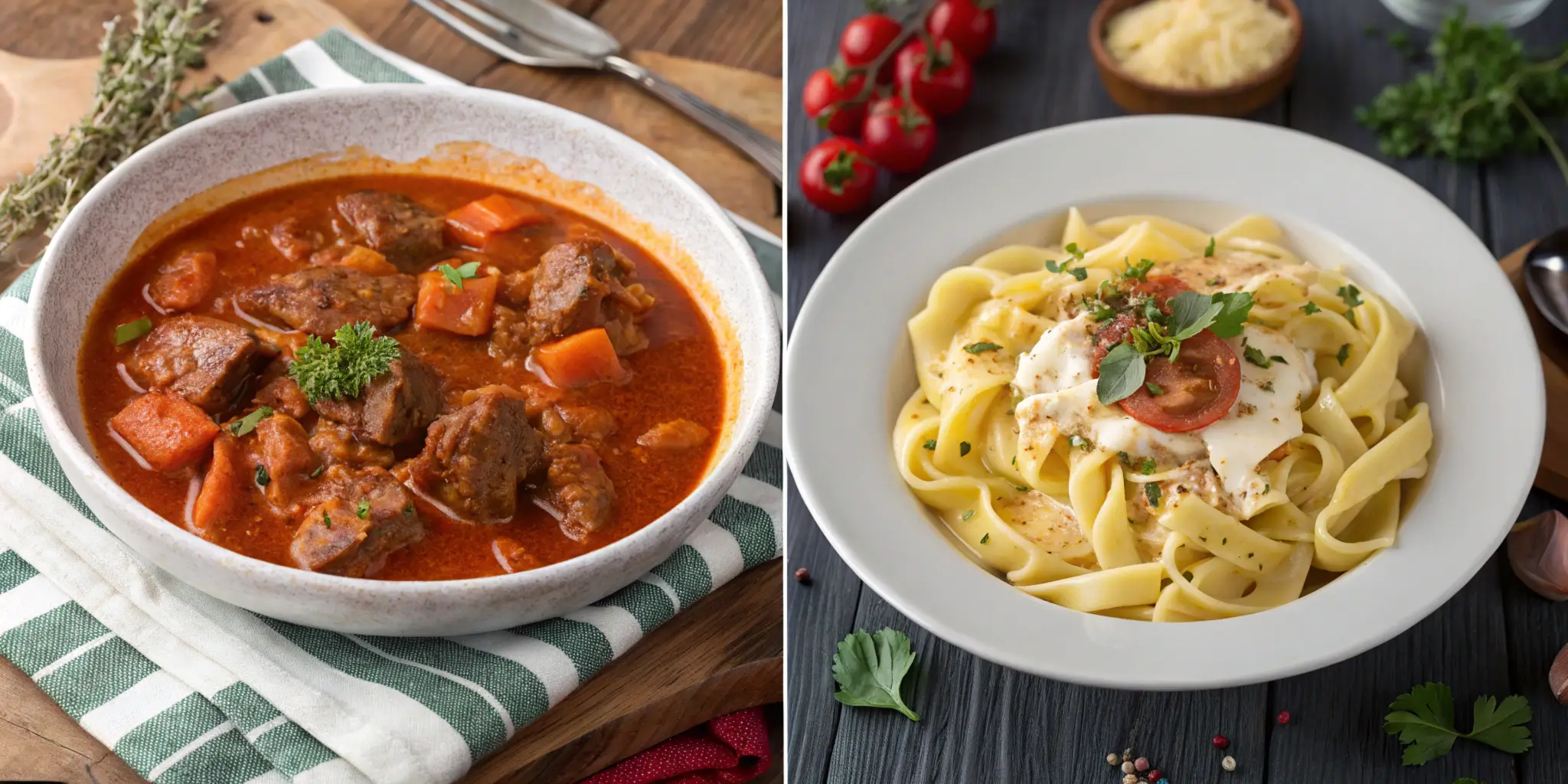Goulash and beefaroni represent two beloved comfort dishes, each with distinct origins, ingredients, and flavors. One comes from Hungary’s rich culinary traditions, while the other showcases American ingenuity in creating simple, hearty meals. This article unravels the key distinctions between goulash and beefaroni, exploring their history, preparation methods, and unique tastes. Let’s dive in!
The Origins of Goulash
Goulash traces its roots back to Hungary, where it began as a humble dish for herdsmen. Known as gulyás in Hungarian, this dish has a long history dating back to the 9th century. Herdsmen would prepare it as a portable stew, using dried meat and vegetables. Over time, the recipe evolved, and paprika became the defining spice, making goulash synonymous with Hungarian cuisine.
Hungary’s rich cultural history intertwines with its food, and goulash symbolizes the spirit of togetherness and comfort. Hungarians continue to honor it as a national dish, cherishing its bold, hearty flavors.
Hungarian Roots and Evolution
Traditional Hungarian goulash combines slow-cooked beef, onions, carrots, potatoes, and, most importantly, paprika. Each family often adds its own twist, creating regional variations.
For an ultimate guide that dives deeper into the history, ingredients, and variations of this beloved dish, visit Beefaroni: The Ultimate Guide to a Classic Comfort Food.
The Emergence of Beefaroni: Difference Between Goulash and American Beefaroni
In contrast to goulash’s deep cultural roots, beefaroni emerged as an iconic American comfort food with a simpler and more modern history. Popularized in the mid-20th century, this dish was marketed as an easy-to-make meal for busy families. Combining pasta, ground beef, and tomato sauce, beefaroni became a favorite for its convenience and nostalgic appeal.
From its humble beginnings in American kitchens to becoming a menu staple, beefaroni carved its place as an affordable and satisfying dish. It provided families with a hearty, crowd-pleasing meal that didn’t strain the budget, differentiating it clearly from the complexity of Hungarian goulash.
Key Differences Between Hungarian Goulash and Beefaroni
| Aspect | Hungarian Goulash | Beefaroni |
|---|---|---|
| Origin | Hungary, dating back centuries | United States, mid-20th century |
| Main Ingredients | Beef, paprika, potatoes, carrots, onions | Ground beef, pasta, tomato sauce |
| Cooking Style | Slow-cooked stew or soup | Quick, one-pot pasta meal |
| Flavors | Bold, smoky, slightly sweet | Mild, tangy, and comforting |
| Cultural Significance | National dish, symbol of Hungarian heritage | American comfort food, practical and nostalgic |
| Preparation Time | Long (hours of simmering) | Short (under 30 minutes) |
| Serving Style | Stew with bread or noodles on the side | Pasta mixed directly with sauce |
| Key Spice | Paprika | Minimal seasoning, optional herbs |
American Adaptation of Beefaroni vs. Hungarian Goulash
Unlike goulash, which boasts a rich cultural heritage, beefaroni reflects American practicality. Its quick preparation, kid-friendly nature, and adaptability make it a go-to dish for busy households. Adding ingredients like cheese or vegetables further enhances its versatility, though its preparation remains much simpler than traditional goulash.
While goulash ties closely to Hungary’s traditions and history, beefaroni evokes warm, homey memories for American families. Its charm lies in its straightforwardness, contrasting with the nuanced flavors and preparation of goulash or beefaroni.
Traditional Ingredients in Goulash: Goulash vs Beefaroni
Hungarian goulash celebrates hearty, simple ingredients that come together to create a flavorful and filling stew. Rooted in tradition, the recipe often varies slightly across regions and families, but a few staples remain constant.
At its core, goulash features cubed beef or veal, carrots, onions, potatoes, and a mix of fragrant spices. The true hallmark of goulash is paprika, a vibrant red spice that gives the dish its signature smoky and slightly sweet flavor. The quality of paprika is so critical to Hungarian goulash and beefaroni comparisons that it can significantly influence the dish’s outcome. The base, typically water or stock, allows the ingredients to meld harmoniously into a savory broth.
Meat, Vegetables, and Spices in Goulash
Traditional goulash relies heavily on tender, slow-simmered meat, usually beef, though lamb or pork can be used in regional adaptations. The slow cooking process ensures the meat absorbs the rich, savory flavors of the broth.
Carrots and bell peppers contribute natural sweetness, while onions deepen the dish’s flavor profile. Paprika pairs beautifully with caraway seeds, bay leaves, and garlic, adding layers of complexity. Some recipes include tomatoes or tomato paste for a touch of tanginess, further distinguishing goulash in the debate of goulash vs beefaroni. This combination creates a bold and earthy dish that’s both satisfying and uniquely Hungarian.
Core Components of Beefaroni
Beefaroni, on the other hand, is a simpler dish with a streamlined list of ingredients designed for quick and easy preparation. At its base, it features three core components: pasta, ground beef, and tomato sauce. These staples create a meal that’s both filling and family-friendly.
Unlike goulash, beefaroni doesn’t rely heavily on spices or vegetables, which keeps the flavors mild and universally appealing. Its simplicity is one of the reasons it’s so popular—almost every pantry has the essentials needed to whip it up in a pinch.
Pasta, Beef, and Tomato Sauce
The pasta used in beefaroni is usually small shapes, like elbows or penne, which hold the sauce well. Ground beef is browned in a skillet and seasoned lightly with salt and pepper. The tomato sauce acts as the glue that ties everything together, often enhanced with a touch of sugar, garlic, or onion powder to balance acidity.
For a creamier texture, some recipes include a sprinkle of shredded cheese stirred into the pasta before serving. This variation adds richness and transforms the dish into an irresistible crowd-pleaser. Whether enjoyed plain or with a cheesy twist, beefaroni’s simplicity makes it a go-to comfort food for many.
How Goulash is Prepared
Cooking goulash is a labor of love that demands patience to unlock its full depth of flavor. Its preparation reflects the traditions of Hungarian cuisine, where the emphasis lies on slow cooking and layering flavors. The result? A rich, comforting stew that warms the soul.
The process typically begins with browning chunks of beef or veal in a heavy pot. This step adds a layer of flavor by caramelizing the meat. Onions are then sautéed in the same pot, absorbing the delicious meat drippings. Paprika is added next, blooming in the heat to release its aroma before other ingredients join the mix. Vegetables such as carrots, bell peppers, and potatoes are stirred in, followed by water or broth to create the stew base.
Slow-Cooking Techniques
One of the most important aspects of preparing goulash is simmering the stew slowly over low heat. This allows the flavors to meld together while tenderizing the meat. Traditional recipes often call for an hour or more of cooking, ensuring the broth develops its signature deep and savory taste.
Using a Dutch oven or cast-iron pot is ideal for maintaining an even temperature. Some modern cooks might opt for a slow cooker, which delivers the same hearty results with minimal supervision. Regardless of the method, patience is key to achieving the bold, complex flavors that make goulash truly special.
Making Beefaroni at Home
Beefaroni offers a quick and fuss-free option, making it perfect for weeknight meals. You can prepare it in just a few steps, with most recipes taking less than 30 minutes. This simple process greatly contributes to beefaroni’s lasting popularity.
To make the dish, start by browning ground beef in a skillet. After cooking the beef thoroughly, stir in tomato sauce, adding seasonings like garlic powder or Italian herbs if desired. While the sauce thickens briefly, boil pasta in a separate pot until tender. Finally, mix the pasta and sauce, tossing everything together to ensure every piece gets coated.
Quick and Easy Steps
To make beefaroni even simpler, many home cooks rely on pre-made tomato sauce or canned ingredients. Some recipes call for mixing shredded cheese directly into the dish, adding a creamy, indulgent touch. For families with kids, this can be a fun opportunity to customize the dish with toppings like extra cheese or even a sprinkle of parsley for a pop of color.
This quick and versatile method ensures that anyone can prepare beefaroni without much effort, making it an enduring favorite in kitchens everywhere.
Taste Characteristics of Goulash
Goulash delivers a bold and satisfying flavor that is as rich as its history. This dish is defined by its hearty ingredients and the masterful balance of savory, smoky, and sweet elements. The slow-cooking process allows each component to meld into a harmonious stew, resulting in a deeply flavorful experience.
The distinct smoky undertone comes from the generous use of paprika, which is the soul of the dish. As the vegetables and meat cook together, they create a broth that is both robust and slightly sweet, thanks to the natural sugars in the carrots and onions. A hint of tanginess often comes from tomatoes, enhancing the depth of flavor.
Rich and Hearty Flavors
The richness of goulash lies in its stew-like texture and the umami flavors released during the cooking process. The tender chunks of beef absorb the spices, while the broth is thickened naturally by the starches from potatoes or occasionally flour. Every bite feels like a warm embrace, offering a comforting complexity that lingers on the palate.
The combination of spices like caraway seeds and bay leaves adds an earthy aroma, while garlic provides a subtle sharpness. For those looking for a quintessential taste of Hungary, goulash is the ultimate representation of rich and hearty flavors in a single dish.
Flavor Notes in Beefaroni
Beefaroni takes a more straightforward approach to flavor, emphasizing mildness and comfort. Unlike goulash, which bursts with spice, beefaroni’s taste is more uniform and predictable, making it a favorite for kids and those seeking nostalgic, simple meals.
The primary flavor comes from the tomato sauce, which acts as the binding element for the dish. It provides a slightly tangy and sweet base that pairs seamlessly with the seasoned ground beef. The pasta adds a neutral, starchy counterbalance, allowing the sauce and beef to shine.
Mild and Comforting Tastes
The mildness of beefaroni’s flavors is part of its charm. It’s not overly spiced or complex, but instead offers a straightforward, satisfying taste. This makes it a dish that’s universally appealing and easily customizable. Add a sprinkle of cheese for richness or a dash of garlic powder for an extra kick, and you’ve got a dish that feels both familiar and indulgent.
For many, beefaroni isn’t just a meal—it’s a reminder of childhood dinners and family gatherings. Its comforting taste is a testament to the beauty of simplicity, proving that sometimes, less really is more.
Nutritional Aspects of Goulash
When it comes to nutrition, goulash stands out as a well-rounded dish that balances protein, vegetables, and flavorful spices. Its stew-like nature means it can pack a lot of nutrients into each serving while still being filling and satisfying.
The nutritional profile of goulash varies depending on the specific recipe and ingredients used. Traditional Hungarian goulash often features lean beef, which is a rich source of protein and essential vitamins like B12 and zinc. The addition of root vegetables like carrots and potatoes brings a healthy dose of fiber, vitamins, and minerals. Paprika, the defining spice, also contributes antioxidants and compounds that promote overall health.To understand the benefits of these nutrients in your diet, visit Healthline.
Caloric Content and Health Benefits
On average, a serving of goulash contains around 300-400 calories, depending on portion size and whether additional starches like bread or noodles are served alongside it. The dish is relatively low in fat when made with lean cuts of meat and prepared without excessive oils or cream.
Goulash’s slow-cooking process enhances nutrient absorption by breaking down tough fibers in the vegetables and meat, making it easier for the body to digest and extract nutrients. The high protein content supports muscle health, while the fiber from the vegetables aids digestion and helps maintain satiety. For those looking for a balanced, nutrient-dense meal, goulash offers a flavorful and wholesome option.
Health Considerations for Beefaroni
Beefaroni, on the other hand, is more of a convenience dish and tends to be less nutrient-dense than goulash. While it delivers a quick and satisfying meal, its nutritional content depends heavily on the quality of ingredients used.
Store-bought or canned versions of beefaroni are often high in sodium and may contain added preservatives or sugars. Homemade versions, however, provide an opportunity to control the ingredients and make the dish healthier. Ground beef offers protein, and tomato sauce provides some vitamins and antioxidants, particularly if it includes real tomatoes.
Macronutrients and Dietary Impact
A typical serving of beefaroni contains between 350-450 calories, with a significant portion coming from carbohydrates in the pasta. The protein content is moderate, depending on how much ground beef is used, and the fat content can vary based on the cut of meat and any additional ingredients like cheese.
While beefaroni is satisfying and provides energy from its carb-heavy base, it lacks the diversity of nutrients found in goulash. Adding vegetables or using whole-grain pasta can improve its nutritional profile, making it a more balanced option. However, for individuals monitoring sodium intake, homemade versions are a better choice to reduce salt levels.
Goulash in Hungarian Culture
Goulash occupies a cherished spot in Hungarian culture, embodying much more than a simple meal—it’s regarded as a national treasure. Its origins date back centuries, showcasing Hungary’s rich culinary heritage and the ingenuity of its people. Known as gulyás, it was traditionally prepared by herdsmen and families in large pots over open fires, creating a meal that fostered community and connection.
In Hungary, goulash extends beyond comfort food to serve as a cultural emblem. Festivals and family gatherings often celebrate this iconic dish. Families pass down recipes through generations, each adding unique touches while remaining faithful to the traditional preparation. The dish also underscores Hungary’s agricultural roots, with its reliance on ingredients like beef and paprika, products tied closely to the nation’s landscape.

A National Symbol
Declared one of Hungary’s national dishes, goulash epitomizes the country’s identity. Its preparation and robust flavors reflect Hungary’s traditions, with ingredients like paprika showcasing the nation’s spice trade and agricultural prowess. Paprika fields and livestock farming are integral to its history, making goulash a dish that connects Hungarians to their land.
Today, goulash serves as a source of pride, representing Hungarian cuisine to the world. Tourists frequently encounter it as a centerpiece of Hungary’s vibrant culinary scene, reinforcing its status as a cultural ambassador.
Beefaroni in American Cuisine
Beefaroni may not carry the historical depth of goulash, but it has carved out its own unique place in American culinary history. Created in the mid-20th century, this dish became a staple for households across the United States, embodying the era’s emphasis on convenience cooking. Families turned to beefaroni for its affordability, ease of preparation, and ability to satisfy even the pickiest eaters.
Its role in childhood and family meals has cemented beefaroni’s legacy as a nostalgic favorite. Whether served during casual gatherings or as a quick weeknight dinner, it continues to charm with its straightforward preparation and comforting flavors.

A Comfort Food Staple
In American kitchens, beefaroni stands out as a quintessential comfort food. It’s a dish that unites people, bringing back memories of simpler times and cozy family meals. Its versatility has helped it remain a favorite for decades, as home cooks experiment with new ways to reinvent the classic recipe. Some add layers of cheese, while others include vegetables to make it healthier.
Though beefaroni lacks the deep cultural ties of goulash, it remains a testament to American ingenuity. It’s an uncomplicated dish that captures the essence of practicality and warmth, proving that sometimes the simplest meals leave the most lasting impressions.
Regional Variations of Goulash
Goulash may have originated in Hungary, but it has traveled far and wide, inspiring countless adaptations across Europe. Each region has added its own spin, resulting in a diverse array of goulash recipes that highlight local ingredients and culinary traditions. While the essence of goulash—hearty, savory, and comforting—remains constant, the variations showcase the dish’s remarkable versatility.
In neighboring Austria, goulash leans heavily on onions and often includes a touch of cream, creating a thicker, richer sauce. German goulash, meanwhile, incorporates wine or vinegar for a tangier flavor profile, diverging from the paprika-forward Hungarian style. Slovakian and Czech versions sometimes add dumplings as a side, making the meal even more filling.
European Interpretations
Italian and Balkan cuisines also feature their own interpretations of goulash. Italian variations might include red wine or oregano, borrowing from the country’s rich stew traditions. In the Balkans, potatoes and bell peppers are frequently used, creating a robust and hearty meal that reflects the region’s agricultural staples.
Each of these adaptations reflects the fusion of Hungarian culinary influence with local tastes, demonstrating how goulash has become a beloved dish far beyond its homeland. Despite the differences, the soul of the dish remains intact—a satisfying stew that warms both the body and spirit.
Modern Twists on Beefaroni
Beefaroni’s simple recipe makes it an ideal canvas for creativity, leading to many modern adaptations that cater to changing tastes and dietary needs. Whether you’re looking for a healthier option or an elevated version for special occasions, there’s a twist on beefaroni for everyone.
Cooks experimenting with new flavors often incorporate bold spices, fresh herbs, or gourmet cheeses to enhance the dish. Vegetarians have reimagined beefaroni with plant-based proteins like lentils or soy crumbles, while those seeking healthier alternatives turn to whole-grain or gluten-free pasta.
Healthier and Gourmet Versions
Health-conscious adaptations might replace ground beef with leaner options like ground turkey or chicken. Adding vegetables such as spinach, zucchini, or mushrooms not only boosts the dish’s nutritional value but also adds layers of flavor and texture.
For a gourmet twist, chefs have created beefaroni-inspired casseroles with béchamel sauce, artisan cheeses, or truffle oil. These versions bring a touch of sophistication to the classic dish while maintaining its comforting essence. Whether simple or elaborate, these modern takes on beefaroni prove that it can evolve while staying true to its roots.
Misunderstandings About Hungarian Goulash and Beefaroni
Goulash vs beefaroni often sparks confusion due to misconceptions about these dishes, especially as goulash has traveled far beyond its Hungarian roots. Many people outside Hungary mistake goulash for other stews or pasta dishes, diluting its authentic identity. This confusion is particularly noticeable in the United States, where “American goulash” is often seen as equivalent to the Hungarian original, despite their significant differences.
A major misunderstanding is the belief that Hungarian goulash always includes noodles. In its traditional form, goulash is a stew-like dish filled with beef, potatoes, and vegetables, naturally thickened through slow cooking. Western adaptations sometimes add pasta, but this doesn’t align with the dish’s original character. Another common mistake is assuming that any beef dish with paprika qualifies as goulash, ignoring the carefully balanced flavors and cooking techniques that define the authentic recipe.
Clarifying the Difference Between Goulash and American Beefaroni
Hungarian goulash celebrates simplicity and bold, hearty flavors. Its defining traits include key ingredients like beef, onions, root vegetables, and paprika. Unlike other stews that rely on flour or thickening agents, goulash depends on the natural starches from its ingredients to achieve the right consistency. The slow-cooking method ensures the flavors meld together perfectly, creating a dish that’s rich and satisfying.
Goulash is also deeply rooted in Hungarian culture and history. Passed down through generations, recipes reflect Hungary’s agricultural traditions and culinary heritage, making goulash much more than just a meal. For those exploring the difference between goulash and American beefaroni, understanding this cultural depth is crucial.
Beefaroni vs. Similar Dishes
When comparing beefaroni or goulash, many mistakenly group beefaroni with other pasta-based dishes, but it has its own unique traits. The combination of ground beef, pasta, and tomato sauce may resemble meals like chili mac or baked ziti, but there are clear distinctions.
Some people confuse beefaroni with chili mac, which features spicier seasonings and a chunkier texture. In contrast, beefaroni has a smoother, milder tomato-based sauce that caters to broader palates. Similarly, while baked ziti and lasagna share ingredients like pasta and tomato sauce, these Italian-inspired dishes involve layering and heavier use of cheese, which sets them apart from beefaroni’s simplicity.
Difference Between Goulash and American Beefaroni
The most common confusion occurs when comparing beefaroni to American goulash. Both dishes mix pasta and meat, but the seasoning and preparation differ. American goulash uses a more intricate seasoning profile, including paprika, garlic powder, and occasionally Worcestershire or soy sauce, resulting in a bolder flavor. On the other hand, beefaroni sticks to its basics—a straightforward combination of ground beef, tomato sauce, and pasta.
Additionally, American goulash is often prepared as a one-pot meal, with the pasta cooking directly in the sauce, creating a heartier texture. Beefaroni, however, typically combines pre-cooked pasta with sauce for a quicker, more streamlined process. These distinctions clarify why the difference between goulash and beefaroni matters, even if their names and ingredients sometimes overlap.
Frequently Asked Questions
How to make beefaroni?
To make beefaroni, start by cooking a small pasta like elbows or penne until al dente. While the pasta cooks, brown ground beef in a skillet, seasoning it with salt, pepper, and optional garlic powder. Once cooked, drain any excess grease and mix in tomato sauce. Simmer the mixture for a few minutes, then combine it with the drained pasta. For an extra touch, stir in shredded cheese and serve warm.
For an in-depth guide with detailed instructions and tips, check out this comprehensive recipe on How to Make Beefaroni: A Step-by-Step Recipe for the Ultimate Comfort Food.
How to make homemade beefaroni?
Homemade beefaroni takes the classic recipe up a notch with fresh ingredients. Begin by browning ground beef with diced onions and minced garlic. In a separate pan, create a simple tomato sauce by simmering crushed tomatoes with basil, oregano, and a pinch of sugar. Cook your pasta of choice until al dente, then mix the beef, sauce, and pasta together. Finish with freshly shredded cheese like Parmesan or cheddar for a flavorful homemade version.
If you’re looking for a simple and easy way to prepare this dish from scratch, check out this step-by-step guide on How to Make Homemade Beefaroni: A Step-by-Step Guide.
What is Beefaroni made of?
Beefaroni is primarily made of three ingredients: ground beef, pasta, and tomato sauce. These create the base of the dish. Additions like shredded cheese, onions, garlic, or herbs can enhance the flavor. Some recipes also include a sprinkle of spices or diced vegetables to create variations of this classic comfort food.
For a complete breakdown of the ingredients and recipes that make up this classic dish, check out What is Beefaroni Made Of? A Complete Guide to Ingredients and Recipes.
Can you eat Beefaroni cold?
Yes, beefaroni can be eaten cold, although it’s traditionally enjoyed warm. When served cold, it works well as a pasta salad alternative. To store it, keep the dish in an airtight container in the refrigerator for up to three days. Eating it cold can make it a quick and easy snack, though many prefer reheating it for the best taste and texture.
What’s the best cheese to use for Beefaroni?
The choice of cheese depends on your preferences! Cheddar is a classic choice for its sharp flavor, while mozzarella adds a creamy and stretchy texture. Parmesan works well for a savory kick, and Monterey Jack offers a milder, buttery taste. A combination of cheeses can also be used to create a richer, more complex flavor.
Summarizing the Differences Between Goulash and Beefaroni

Goulash and beefaroni, though both hearty and comforting, are distinctly different dishes with unique origins, ingredients, and preparation methods. Goulash, a staple of Hungarian cuisine, is a slow-cooked stew that highlights tender chunks of beef, root vegetables, and a bold paprika-infused broth. Its rich history and cultural significance in Hungary make it a dish steeped in tradition, with variations found across Europe.
On the other hand, beefaroni is a quick and simple American creation featuring pasta, ground beef, and tomato sauce. Known for its mild, kid-friendly flavors, beefaroni is a practical comfort food that prioritizes convenience and adaptability. Unlike the spice-forward profile of goulash, beefaroni leans toward a more uniform and subtly sweet taste, often complemented by cheese.
Cooks often prepare goulash as a soup-like stew, pairing it with bread or noodles on the side. In contrast, beefaroni comes together as a one-pot meal, mixing the pasta and sauce for easy serving.
These key differences in preparation, flavor, and cultural ties highlight the unique identity of each dish. Whether you prefer the complex, hearty essence of goulash or the simplicity and nostalgia of beefaroni, both offer satisfying culinary experiences in their own right.

